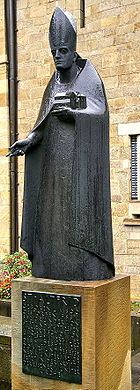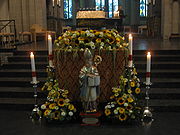
Altfrid
Encyclopedia


Essen Abbey
Essen Abbey was a collegiate foundation for women of the high nobility in Essen. It was founded in about 845 by the Saxon Altfrid , later Bishop of Hildesheim and saint, near a royal estate called Astnidhi, which later gave its name to the religious house and to the town...
. He was also a close royal adviser to the East Frankish King Louis the German
Louis the German
Louis the German , also known as Louis II or Louis the Bavarian, was a grandson of Charlemagne and the third son of the succeeding Frankish Emperor Louis the Pious and his first wife, Ermengarde of Hesbaye.He received the appellation 'Germanicus' shortly after his death in recognition of the fact...
.
He is a Roman Catholic saint. His feast day is celebrated on 15 August, the feast of the Assumption of the Virgin Mary
Assumption of the Virgin Mary
Many significant works of art depict the Assumption of the Virgin Mary. They include:* Assumption of the Virgin by Francesco Botticini* Assumption of the Virgin by Titian* Assumption of the Virgin by Antonio da Correggio...
, but also in Essen and Hildesheim on 16 August.
Life
There is no contemporary biography of Altfrid. He is first mentioned by name on 3 October 852, when he took part in a council in MainzMainz
Mainz under the Holy Roman Empire, and previously was a Roman fort city which commanded the west bank of the Rhine and formed part of the northernmost frontier of the Roman Empire...
as Bishop of Hildesheim.
According to the Hildesheim Chronicle Altfrid died "rich in days" in 874, from which a year of birth of around 800 is assumed. He owned land in the Harz
Harz
The Harz is the highest mountain range in northern Germany and its rugged terrain extends across parts of Lower Saxony, Saxony-Anhalt and Thuringia. The name Harz derives from the Middle High German word Hardt or Hart , latinized as Hercynia. The legendary Brocken is the highest summit in the Harz...
vorland and in central Essen
Essen
- Origin of the name :In German-speaking countries, the name of the city Essen often causes confusion as to its origins, because it is commonly known as the German infinitive of the verb for the act of eating, and/or the German noun for food. Although scholars still dispute the interpretation of...
(Asnithi), which may have been inherited from his family, and it seems likely that he belonged to the Saxon
Saxons
The Saxons were a confederation of Germanic tribes originating on the North German plain. The Saxons earliest known area of settlement is Northern Albingia, an area approximately that of modern Holstein...
nobility, but probably not to the later Imperial family of the Liudolfings, as they had no influence in Altfrid's foundation Essen Abbey (Stift Essen) until after his death, although the two families may nevertheless have been connected.
He was apparently a monk at Corvey Abbey
Corvey Abbey
The Imperial Abbey of Corvey was a Benedictine monastery on the River Weser, 2 km northeast of Höxter, now in North Rhine-Westphalia, Germany....
before he was declared Bishop of Hildesheim in 851 in succession to Ebbo, who died on 20 March of that year. Since Ebbo had been installed and removed several times as Archbishop of Reims
Archbishop of Reims
The Roman Catholic Archdiocese of Reims is an archdiocese of the Latin Rite of the Roman Catholic Church in France. Erected as a diocese around 250 by St. Sixtus, the diocese was elevated to an archdiocese around 750...
, Altfrid took the unusual step of repeating all consecrations and ordinations of his predecessor to avoid their invalidation.
In 864, Altfrid moved the relics of Saint Marsus from Auxerre
Auxerre
Auxerre is a commune in the Bourgogne region in north-central France, between Paris and Dijon. It is the capital of the Yonne department.Auxerre's population today is about 45,000...
to an unknown place in Saxony, most likely to Corvey Abbey. His sermon on the arrival of the relics survives. In addition, Altfrid laid the cornerstone of a new cathedral in Hildesheim in 852, a three-aisled cruciform church with a crossing and transept. It was completed in 872 and was consecrated on 1 November 872 in the presence of four bishops and the Abbot of Corvey.
Even before his consecration as bishop, Altfrid had been active in the foundation of several female religious communities. Between 845-847 he acquired the relics of Saints Cosmas and Damian
Saints Cosmas and Damian
Saints Cosmas and Damian were twin brothers, physicians, and early Christian martyrs born in Cilicia, part of today's Turkey. They practiced their profession in the seaport of Ayas, Adana, then in the Roman province of Syria...
in Rome. Altfrid also supported the Saxon Count Ricdag in the foundation of the nunnery at Lamspringe
Lamspringe Abbey
Lamspringe Abbey is a former religious house of the English Benedictines in exile, at Lamspringe near Hildesheim in Germany.-First foundation:...
by procuring for it the relics of Saint Hadrian from Rome.
According to the Hildesheim Chronicle Altfrid also founded a Benedictine monastery on his own land in the Harzvorland, of which no further details of either location or duration are known. More important is Altfrid's other foundation, Essen Abbey
Essen Abbey
Essen Abbey was a collegiate foundation for women of the high nobility in Essen. It was founded in about 845 by the Saxon Altfrid , later Bishop of Hildesheim and saint, near a royal estate called Astnidhi, which later gave its name to the religious house and to the town...
(Stift Essen), on his own property in Essen (Asthnide) on the Hellweg. The first Abbess of Essen was his kinswoman Gerswith, often referred to as his sister, although there is no direct evidence of this. As in Hildesheim, Altfrid also built a church for the canonesses, the Stiftskirche, later known as the Essener Münster and from 1958 as Essen Cathedral
Essen Cathedral
Essen Minster or Cathedral is the seat of the Roman Catholic Bishop of Essen, the "Diocese of the Ruhr", founded in 1958...
. Altfrid was buried here after his death on 15 August 874, according to his wishes. A Gothic
Gothic architecture
Gothic architecture is a style of architecture that flourished during the high and late medieval period. It evolved from Romanesque architecture and was succeeded by Renaissance architecture....
tomb stands over his grave in the east crypt, which is named after him.
Diplomat
Altfrid, described in a letter from Bishop Hincmar of Reims as a clever and sober thinker and gifted with eloquence, was a close confidant of Ludwig the German, and from 860 took an influential role in the power struggles between the various parts of the disintegrating Frankish empire. In 860 Altfrid was present at the meeting between Ludwig the German and Charles the BaldCharles the Bald
Charles the Bald , Holy Roman Emperor and King of West Francia , was the youngest son of the Emperor Louis the Pious by his second wife Judith.-Struggle against his brothers:He was born on 13 June 823 in Frankfurt, when his elder...
in St. Castor's Basilica in Koblenz
Koblenz
Koblenz is a German city situated on both banks of the Rhine at its confluence with the Moselle, where the Deutsches Eck and its monument are situated.As Koblenz was one of the military posts established by Drusus about 8 BC, the...
, where the two kings agreed a peace treaty. In the years that followed it is possible to trace a great deal of travelling on Altfrid's part: in 862 he was in Asselt, later in Compiègne
Compiègne
Compiègne is a city in northern France. It is designated municipally as a commune within the département of Oise.The city is located along the Oise River...
and Savonnières
Savonnières
Savonnières is a commune in the Indre-et-Loire department in central France.-See also:*Les Grottes Pétrifiantes de Savonnières*Communes of the Indre-et-Loire department...
, in 864 in Pitres
Pîtres
Pîtres is a commune in the Eure department in Haute-Normandie in northern France. It lies on the Seine.-History:Historically, it had a bridge to prevent Vikings from sailing up the river to Paris. It was here that King Charles the Bald promulgated the Edict of Pistres in...
, in 865 at the Synod of Thousey and in 867 in Metz
Metz
Metz is a city in the northeast of France located at the confluence of the Moselle and the Seille rivers.Metz is the capital of the Lorraine region and prefecture of the Moselle department. Located near the tripoint along the junction of France, Germany, and Luxembourg, Metz forms a central place...
. Altfrid had decisive influence on the form of the Treaty of Meerssen
Treaty of Meerssen
The Treaty of Meerssen or Mersen was a partition treaty of the Carolingian Empire concluded on 8 August 870 by the two surviving sons of Emperor Louis the Pious, King Charles the Bald of West Francia and Louis the German of East Francia, at Meerssen north of Maastricht, in the present-day...
, which divided Lotharingia
Lotharingia
Lotharingia was a region in northwest Europe, comprising the Low Countries, the western Rhineland, the lands today on the border between France and Germany, and what is now western Switzerland. It was born of the tripartite division in 855, of the kingdom of Middle Francia, itself formed of the...
on 9 August 870 between West Francia and East Francia.
Death and after
The place of Altfrid's death is not known, although the date is recorded by Abbot Altbert of Lobbes as the feast of the Assumption of the Virgin Mary, i.e., 15 August 874. He was buried, according to his wishes, in the church of Essen Abbey.After his death Altfrid was particularly venerated at his tomb in Essen. Around the year 1000 miracles were reported at his grave, which greatly increased the veneration, and the effects of a supposedly healing spring close to the church were also ascribed to his intercession. After a serious fire in the church in the 13th century a Gothic stone sarcophagus
Sarcophagus
A sarcophagus is a funeral receptacle for a corpse, most commonly carved or cut from stone. The word "sarcophagus" comes from the Greek σαρξ sarx meaning "flesh", and φαγειν phagein meaning "to eat", hence sarkophagus means "flesh-eating"; from the phrase lithos sarkophagos...
was obtained for his bones. Altfrid's feast day - which in Essen was celebrated on 16 August, rather than on 15 August - was the most festive in the abbey's yearly calendar.
Nevertheless Altfrid was not a canonised saint, and when the abbey was secularised in 1803 his veneration fell off, only to revive during the Kulturkampf
Kulturkampf
The German term refers to German policies in relation to secularity and the influence of the Roman Catholic Church, enacted from 1871 to 1878 by the Prime Minister of Prussia, Otto von Bismarck. The Kulturkampf did not extend to the other German states such as Bavaria...
at the end of the century. After the foundation of the Bishopric of Essen in 1958 the first bishop asked Rome to confirm the celebration of Altfrid's feast day as an official church festival, a request which was granted in 1965.

